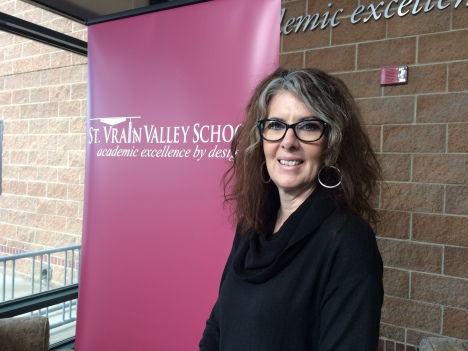Hello! Welcome back to our Stapp Inspires Teacher Highlight! During the last several months, we have been introduced to some amazing teachers, coaches and administrators in the District. This month, we are going to switch gears and take a step out of the classroom. We are going to take a look at someone who works tirelessly behind the scenes. This month’s highlight is Board member Paula Peairs.
Paula was elected to the school board in 2013 and was recently re-elected to a second four-year term. Paula represents the Mead and Skyline feeder systems. While she does represent those areas, she feels a responsibility to the entire community for the success of the District. She is the proud mom of two St. Vrain alumni and still has one in the District.

I had a chance to meet with Paula and learn a little bit more about her and her journey to the school board. Her journey is a relatable one. She started by volunteering in her children’s schools and attending PTO meetings. From there, she was elected PTO president and eventually wound up being one of the founding members of Grassroots St. Vrain. This group was focused on painting an accurate and truthful portrait of school funding, and clearly communicating the needs of the school district ahead of the 2008 mill levy override. From there, she joined Leadership St. Vrain where she discovered even more about District operations and education-related legislation.
Running for a position on the school board was the next logical step for Paula. She grew up in a community that strongly supported schools, and felt she could highlight what was going on in the District. Paula believes very strongly that community support is one of the greatest strengths of St. Vrain Valley Schools.
I asked Paula to give me an overview of how our school board functions. To start, St. Vrain has seven board members where most districts only have five members. By having a larger school board, there is more representation of the community and more ideas. Board members are elected to four-year terms on odd years. Each board member may serve two four-year terms. On election years, either three or four seats are available. Board members are elected “at large”, meaning they represent a specific area, but still make decisions about the success of the entire District. Board members help guide the direction of the school district as a whole.
We also discussed the difference between a bond and a mill levy as there is a big difference between the two. So, if you are like me, and didn’t realize the difference, here is a quick run- down. Voter approved elections for school districts generally involve either a capital improvement bond or a mill levy override. Both of these are funded through established mill levies that generate property tax revenues to pay for expenditures. A mill levy is the “tax rate” that is applied to the assessed value of a property. Capital improvement bonds are sold and the proceeds are used strictly for physical improvements – brick and mortar projects, technology and other enhancements. These bonds are typically repaid over 20 – 25 years and the mill levy sunsets – or ends – when those bonds are completely repaid. Through a mill levy override, community members vote to increase the mill levy rate to fund local schools. Funds generated by mill levies can be used for operational expenses, professional development and increasing overall student achievement. This mill levy can either sunset or continue forever depending on the approved ballot language. Because capital improvement bonds and mill levy overrides are used for different District resources, community members might see school districts ask for a bond one year and a mill levy another.
I asked Paula what was the biggest success she has been a part of as a Board member. She said, “We have so much community support. Superintendent Haddad has been able to gain the trust and support of the community. That has been invaluable in helping make sure we can provide equitable resources to each student.” In the past, smaller communities in the District have felt overshadowed. The Board has worked hard to make sure resources enjoyed by larger communities are available to the smaller communities as well. She emphasized that it shouldn’t matter which zip code you live in, because every student should have access to highly qualified staff, safe learning environment and the latest technology.
She went on to explain that, because of the District’s size, they are able to do things on a larger scale. The District has looked at ways to centralize operations as much as they can. Having a central office focused on bus routes, food service, finance, and human resources allows principals to concentrate on the administration of their schools. The Board wants the principals to be building coaches, to know what is going on in their schools, and to be able to create an environment supportive of learning.
Our time was almost done, and I had one last question for Paula. I wanted to know what she had most enjoyed about her time on the Board. “Hearing community stories and being able to share my knowledge and resources with the community. There was a time when new school boundaries needed to be drawn and people couldn’t wait to leave their school. During a recent boundary meeting, parents came in and asked for their students to remain at their current school because they love the teachers and staff where they are. I’m optimistic about the future of St. Vrain Valley Schools.”
Paula, thank you for helping make St. Vrain Valley Schools one of the top districts in the state. We appreciate your time and for serving on the Board. Because of caring, involved people like you, the students of St. Vrain have amazing opportunities.
Filed under: Stapp Inspires Educator Highlights 2017-2018 | Tagged: Paula Peairs, School Board, St. Vrain Valley Schools | Leave a comment »


